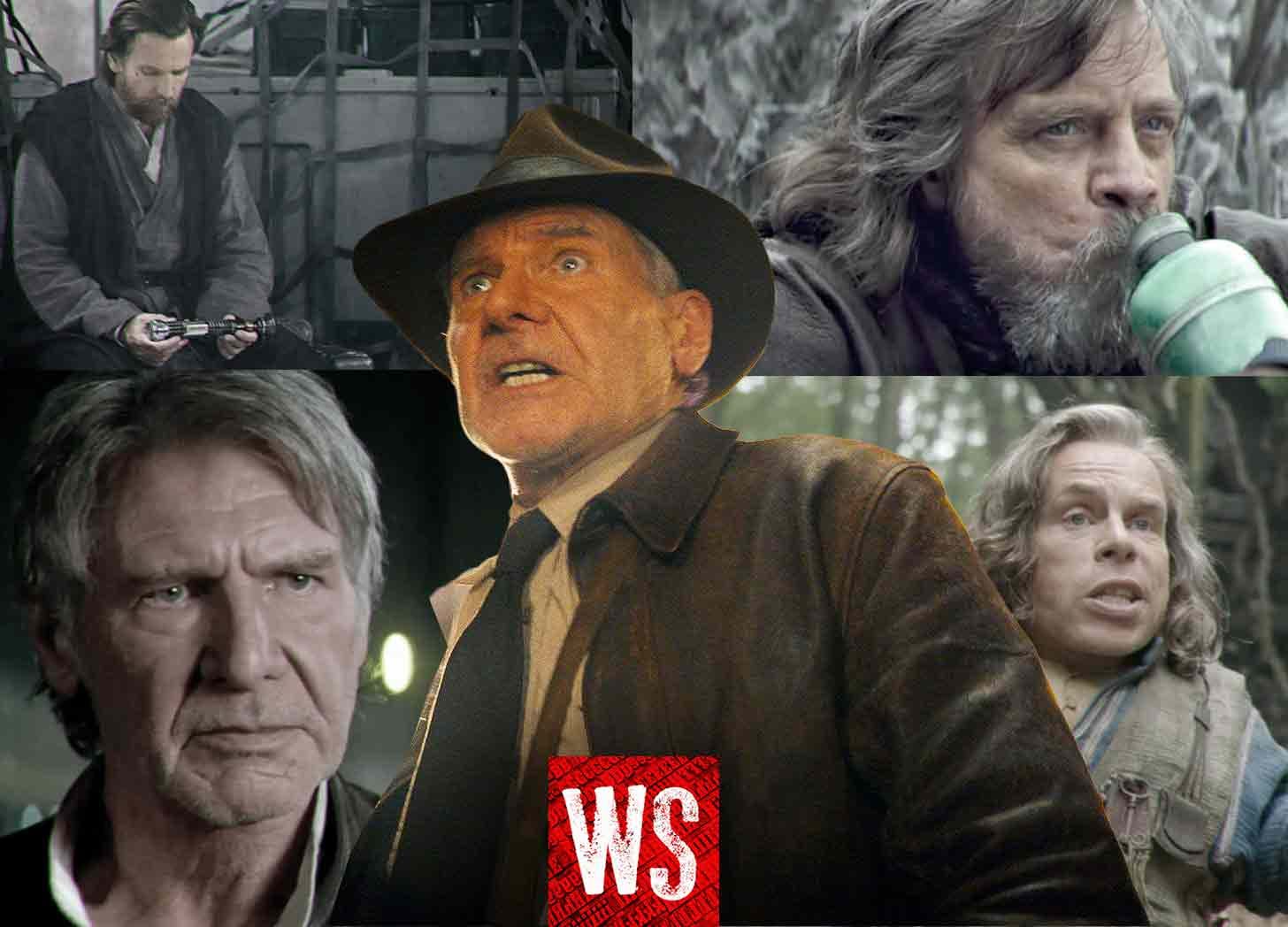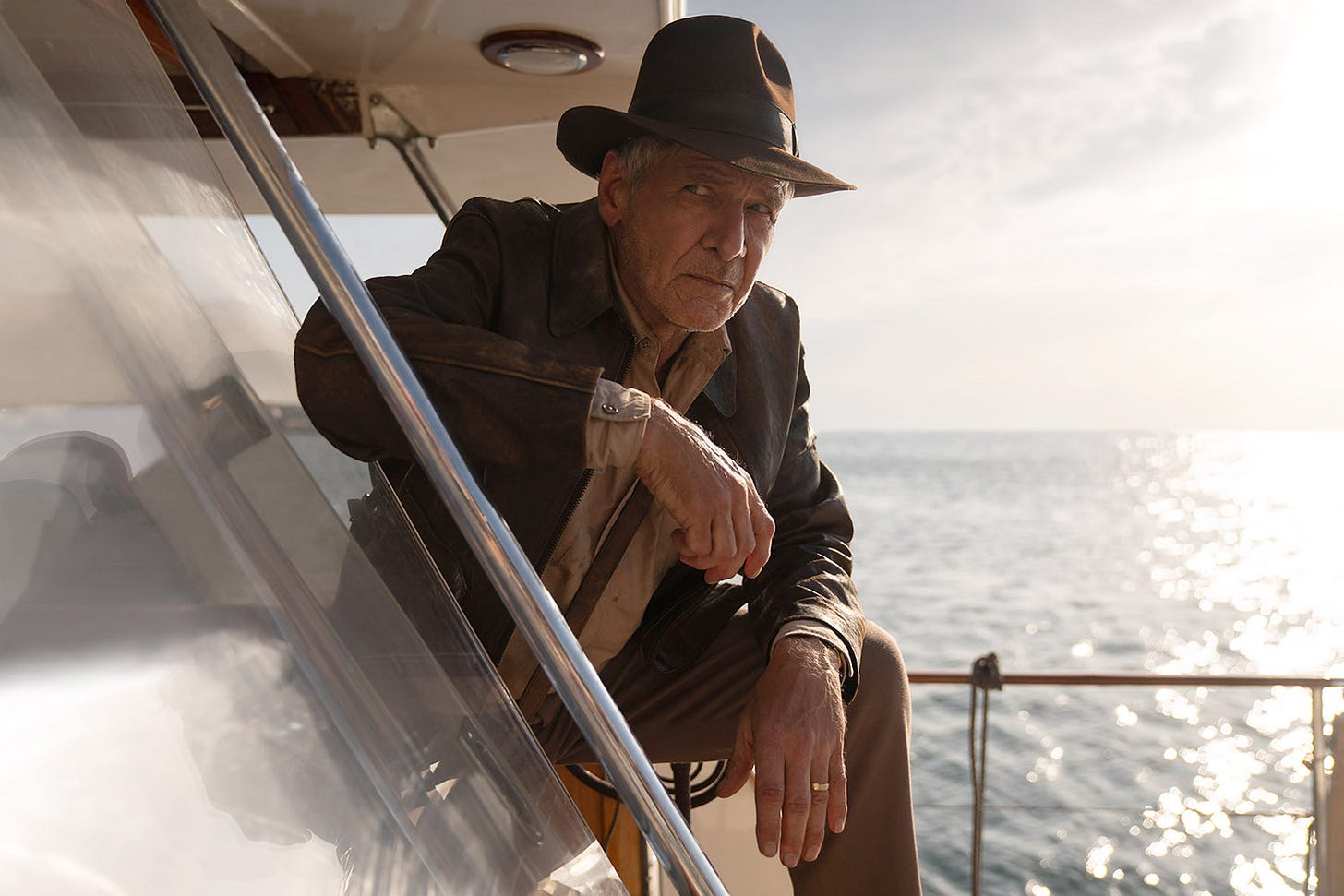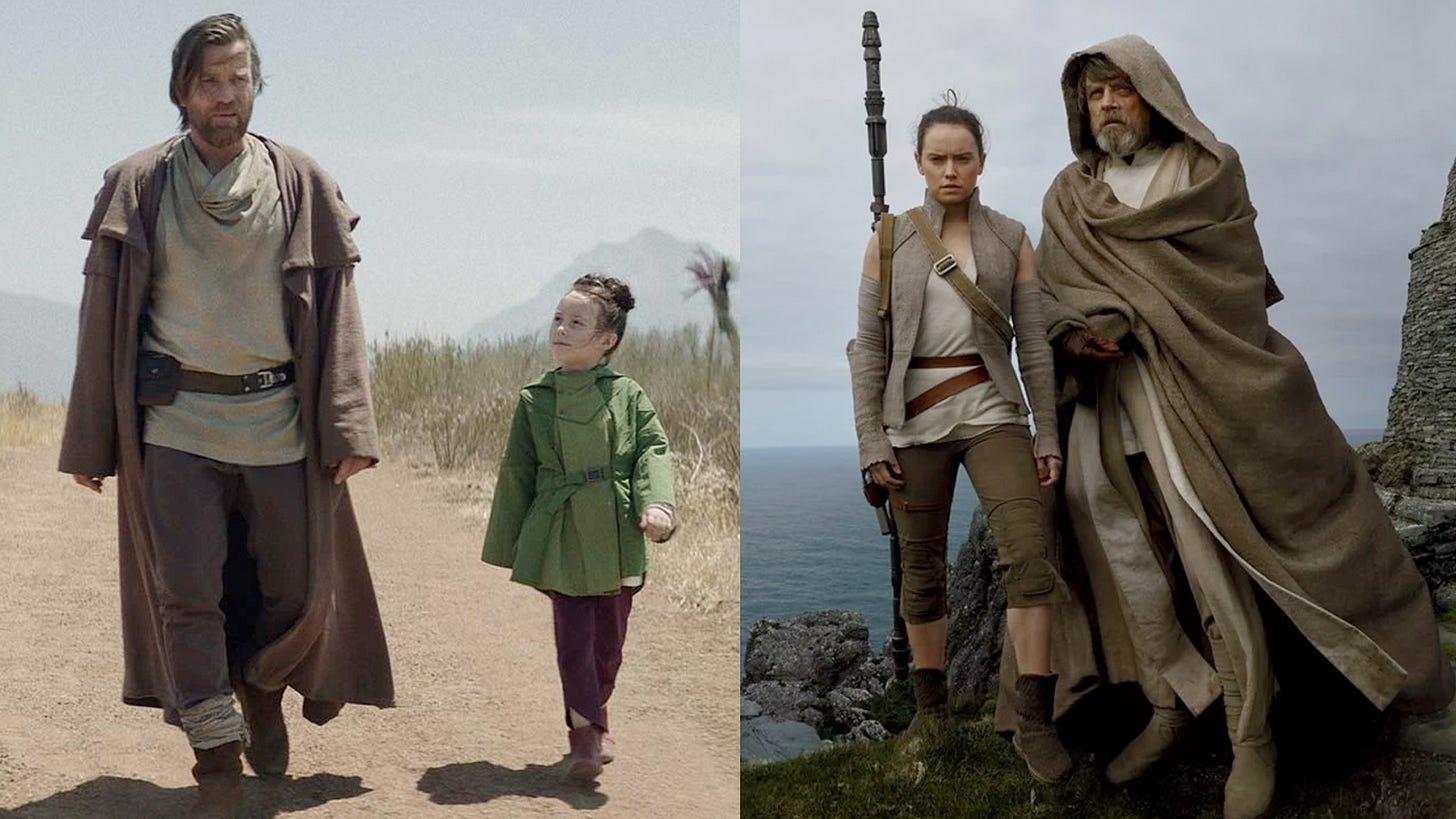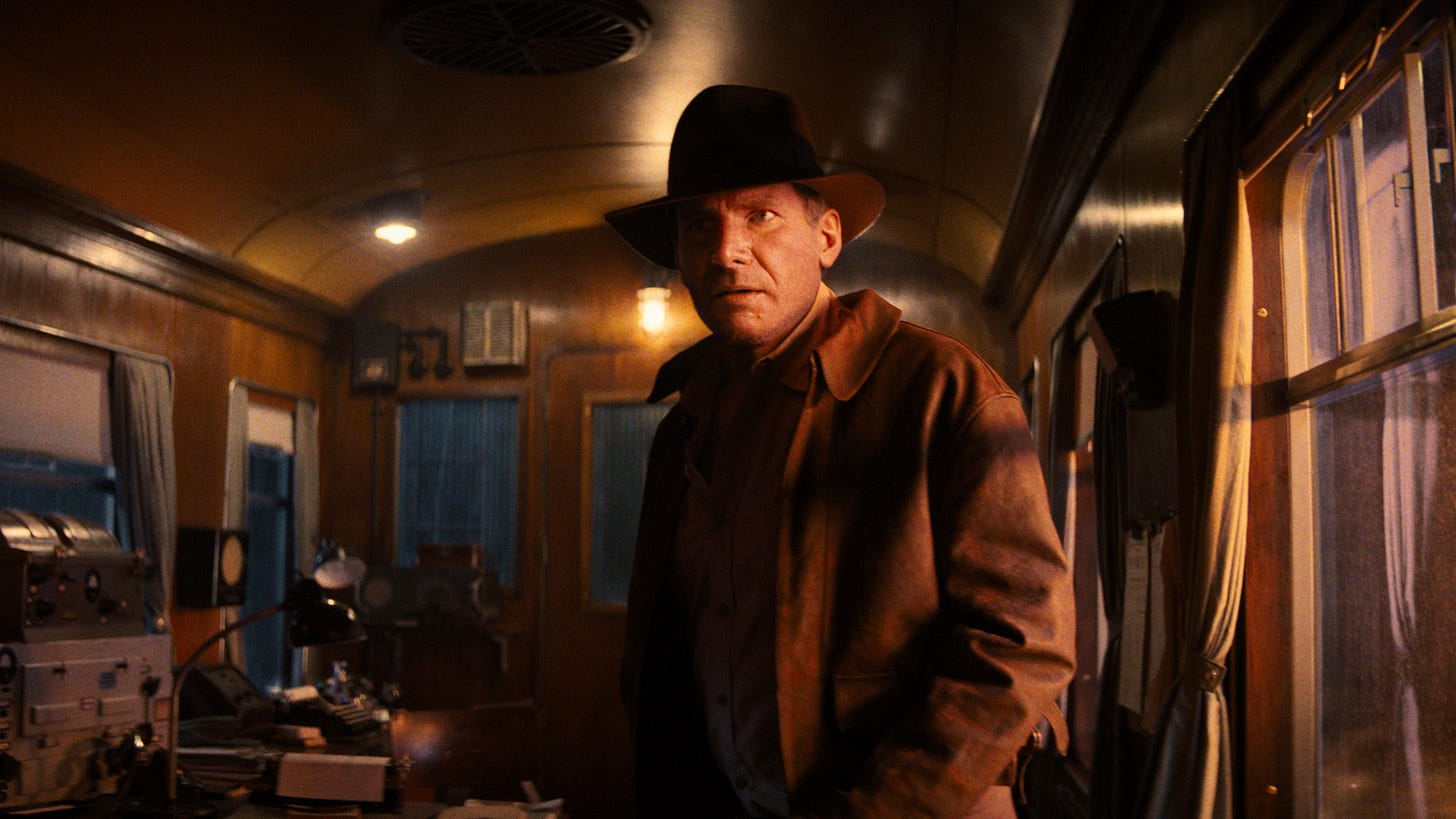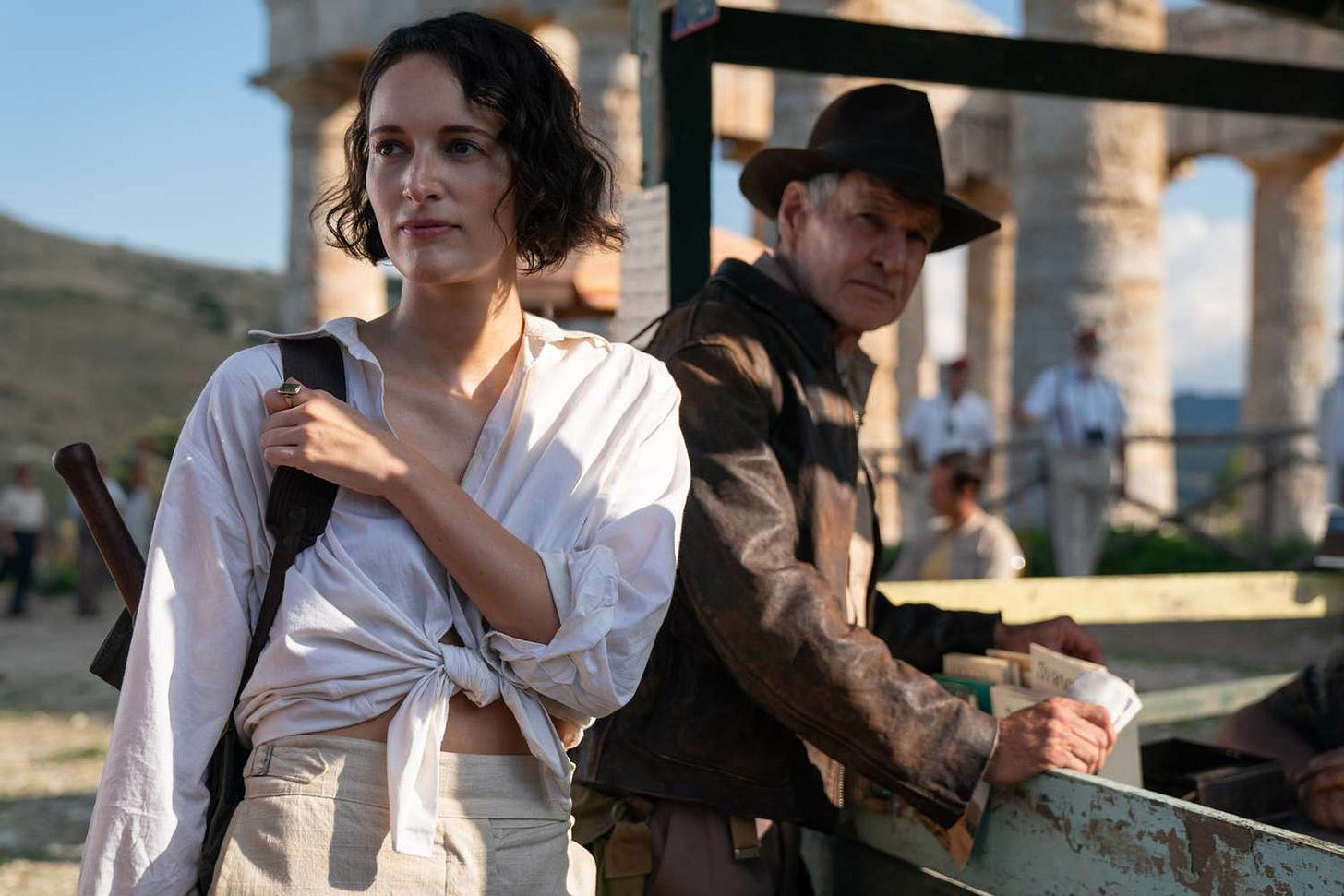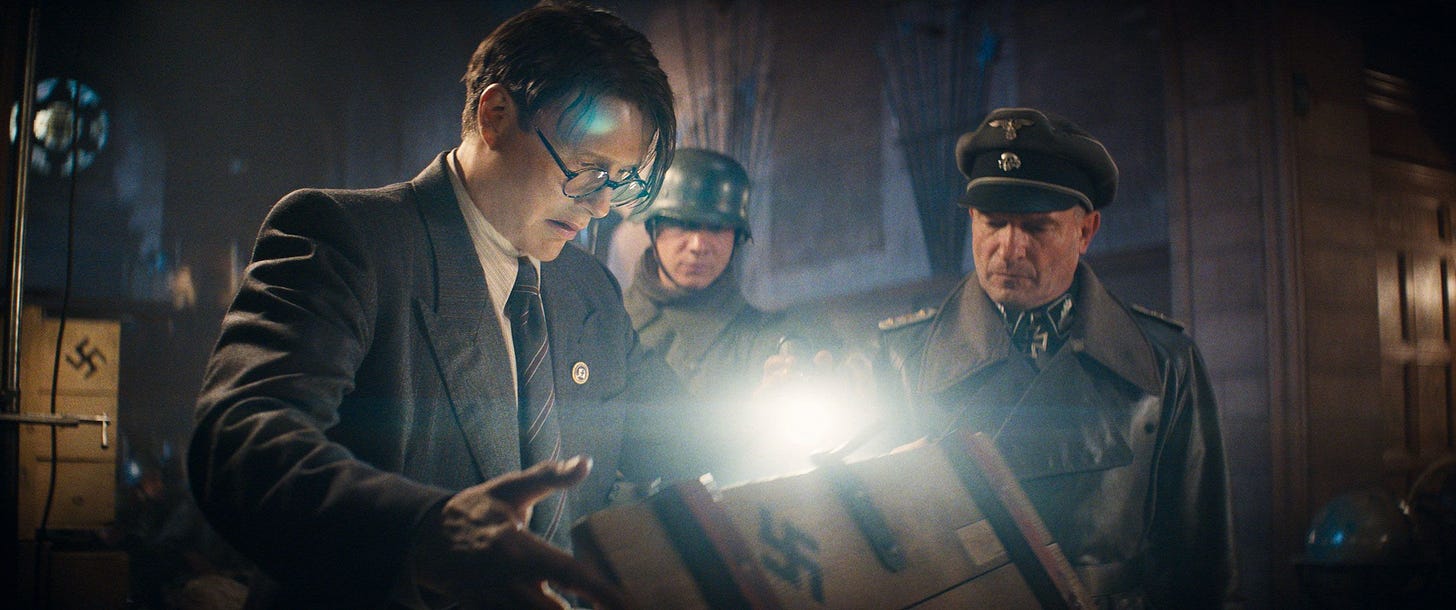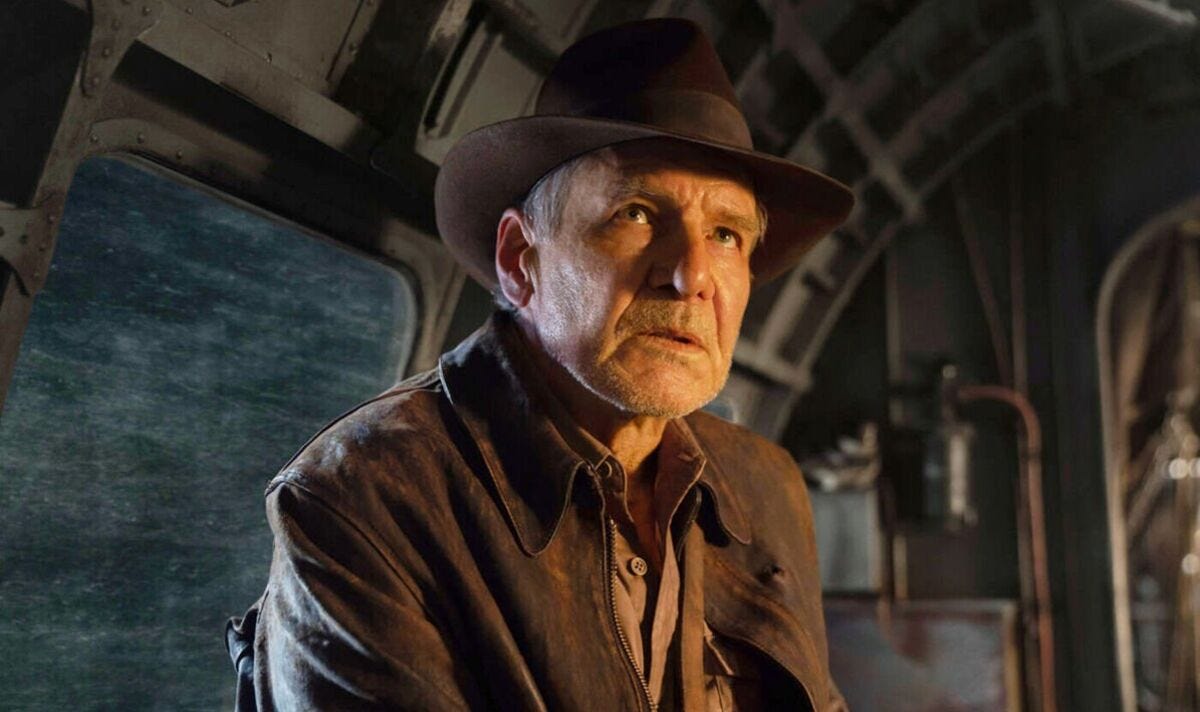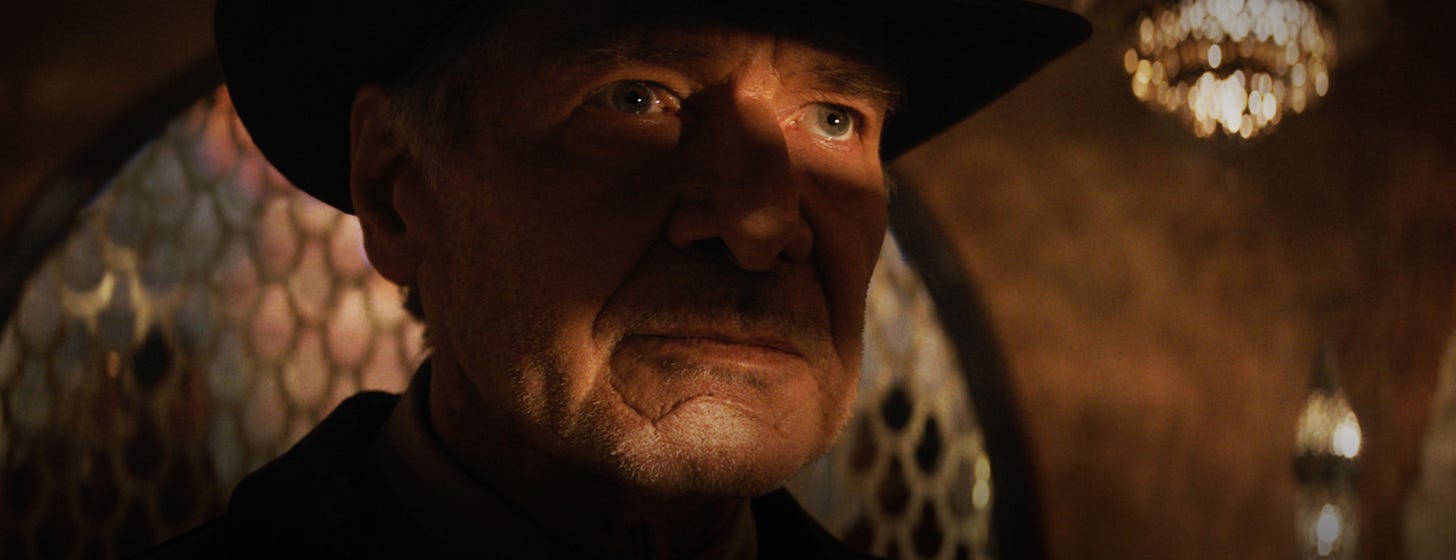Indiana Jones and The Tired Old Man Trope
Lucasfilm continues to crumble under the weight of false stereotypes
As talk of a new Indiana Jones movie made the rounds years after the last one dropped, the rumors were always fun, engaging, and sometimes infuriating. Rumors of the possible storyline, recasting, and everything under the sun created a world of possibility for more Indy adventures, with most fans simply hoping for something better than 2008’s much-maligned Indiana Jones and the Kingdom of the Crystal Skull.
When the news came that the film was, indeed, going forward and that Spielberg would be passing the director’s chair to Logan director James Mangold, many felt a sense of hope, excitement, and trepidation. Would Lucasfilm learn from the mistakes of Crystal Skull (overuse of CGI, half-baked new characters, etc.) and finally give the fans a proper send-off to the much-loved globe-trotting archaeologist played by Harrison Ford with Indiana Jones and the Dial of Destiny?
The answer, sadly, is no.
In fact, they made a film that is somehow worse than Spielberg’s last attempt, which in retrospect now looks like a more fitting follow-up than Dial of Destiny, which takes the franchise in a depressingly dull, surprisingly sad, and completely asinine direction. With a writing team that includes Jez Butterworth and John-Henry Butterworth and David Koepp and James Mangold, Dial of Destiny feels both overwritten and underwritten at once, like a tug-of-war of ideas from different writers building an Indiana Jones vision board.
Unfortunately, that vision board became a story about a sad, lonely, depressed Indiana Jones living in a dinky New York apartment, while working as a low-level university professor set to retire. Divorce papers from Marion sit on the table and his story only gets bleaker from there, just as his Goddaughter, Helena Shaw (Fleabag’s Phoebe Waller-Bridge), surfaces to pull him into an all-new adventure.
The adventure in question is to find and connect together a time-travel device created by the mathematician Archimedes called the Antikythera (the “dial” of the title), which apparently drove Shaw’s father (Toby Jones) mad, prompting Jones to take the piece of the device and conceal it for decades. Shaw, however, is in it for the money, not the preservation of history, and steals the piece of the device that Jones had hidden away. This situation leads to Jones being framed for murder and on the run to clear his name, which sends him to Egypt on the trail of Shaw. Eventually, they team up to evade a bigger threat, a German engineer (Mikkelsen) that’s actually a Nazi who has his eyes on the dial of destiny as well, but with some very evil and ambitious plans.
So, there’s the synopsis, which seems like it could work, but it all just stumbles along, flatlining at every turn with a creatively bankrupt journey that trades on everything that came before in the franchise, yet never finding a single frame to leave a lasting impression. Gone are the iconic shots, the heroic gestures, the display of Jones’ intuition and prowess, replaced with another Mary Sue co-lead, lackluster side characters, and generic, by-the-numbers action scenes that are muddled in CGI and missing any kind of ingenuity that the first three films displayed.
The first major problem with Dial of Destiny is the use of the now-trademarked Lucasfilm legacy character treatment: Old, white, male franchise lead character is now a sad, grumpy recluse existing as a shell of their once-respected self, upstaged and replaced by a female sidekick primed to take his place or, at the least, to steal the spotlight without earning it.
Luke Skywalker, Obi-Wan Kenobi, Willow, and now Indiana Jones (may as well toss Han Solo on that fire, too). Apparently, if you were a white, male hero in a popular franchise for the last few decades, your time is now up. Hand in your whip, lightsaber, and magic stick and prepare to tell the Jawas, Nazis, and Brownies to get off your lawn. I don’t know where it’s written that every single male who lives long enough to get old is going to end up a curmudgeonly old asshole with no loved ones, wealth, or accomplishments, but it must be inscribed within the halls of Lucasfilm at this point. There’s just no world where men grow old, live happily, enjoy success, and have children and grandchildren to help keep them company and further their legacy. Nope, here at Lucasfilm they’re all washed-up old turds with nothing to show for their previous accomplishments, like saving the galaxy/civilization/fantasy world time and again.
The script and general story for Dial of Destiny is the most glaring problem, but it only gets worse from there. The CGI is the next biggest problem, as the attempts to de-age Ford for the opening are shoddy at best. For a film that cost nearly $400 million and with the visuals being handled by ILM, you’d be right to expect better. Unfortunately, it’s a mess of smudgy movements and some surprisingly obvious out-of-sync dialogue that robs the audience of ever being able to fully accept the scenario.
But, it’s not just the VFX for the de-aging that hinder Dial of Destiny; the whole movie looks like it was shot on a green screen, which may be fine for Star Wars, but the Indiana Jones films always thrived on the real locations and sets that made for a far more immersive experience. It’s one of the major complaints of Kingdom of the Crystal Skull, which felt like Spielberg’s laziest attempt at the series, resting on CGI to do the heavy lifting that practical pulled off before.
Now, sure, the previous films also have CGI and VFX, many of which don’t hold up so well today. But, the first three films also had an inspired and creative script, bold set pieces, inventive action scenes, and memorable characters, making it that much easier to suspend disbelief when the VFX suffered. Dial of Destiny, however, never feels like we’re in an actual place that exists on planet Earth. From New York City to Tangiers to the bottom of the ocean, it all looks shot on a set or in front of a green screen, making for something that looks like it was made for Disney+ rather than an IMAX screen.
The characters in Dial of Destiny are a hodgepodge of ho-hum, including Mads Mikkelsen as the lead villain, who does exactly what’s asked of him, but never rises to the level of previous franchise bad guys that left a more indelible mark. Boyd Holbrook pulls henchman duty, never showing an ounce of personality that defines him outside of being a cold-blooded killer, a shame as he’s far more capable. Shaunette Renée Wilson plays a CIA agent aligned with the bad guys, but suddenly has a conscience even after being complicit in multiple innocent deaths, making her character a perplexing and annoying one.
John Rhys-Davies returns as Sallah, Indy’s lifetime pal, now living in the U.S., giving Indy his only real connection to the past, but far too old to fight Nazis. It’s a shame he was left out of Crystal Skull, where he could’ve taken a much bigger role, but with Dial he’s little more than a cameo in the final chapter.
This brings us to Phoebe Waller-Bridge’s Shaw, who takes up about as much screen time as Indy, working overtime to steal the show (and the hat and whip). There was a lot of speculation about the film taking on some reshoots and restructuring of her character in the final cut, with reports suggesting that Indy would die and she would take over the mantle. I’m apt to believe that description, as the finale could easily have gone that route and it seems like it was originally shot that way.
I loved Waller-Bridge in Amazon’s Fleabag, where she played a cheeky, thirsty, sassy, and free-spirited woman with a dash of dark humor as she navigates her dating life. In Indy V she plays a cheeky, thirsty, sassy, and free-spirited woman with a dash of dark humor as she navigates her way into a franchise. She may now be a PG-13 rated Fleabag, but she’s still just Fleabag, and that’s just not interesting or compelling enough for an Indiana Jones movie.
Waller-Bridge has surfed the wave of her success from that show, making a jab at becoming a big-name star, which is perfectly normal for Hollywood. She was even brought in to do some writing for the last James Bond film, No Time To Die, and is poised to take over the role of Lara Croft: Tomb Raider for Amazon Studios. In many ways, Dial of Destiny is a litmus test for that. Unfortunately, it doesn’t work. For all her charm in Fleabag, it’s of little use with Dial of Destiny, due largely to the fact that she’s written and portrayed as someone without a conscience or humility.
At one point a character is killed and Jones and Shaw make their escape. Shaw is laughing at their escape and thrilled that they one-upped the villains. Indy, meanwhile, sits there incredulously: “One of my friends was just murdered…” Shaw shrugs in an “oopsie” kind of way. “Oh. Sorry.” It’s these kinds of moments where Shaw could’ve shown her humanity and heart, something that Jones always had to spare and something that made him a more relatable character. Shaw is a cartoon, ripe with all the answers, quips, and prowess to handle any and all situations. At one point she even knocks out Indiana Jones with a single punch and I was curious why she didn’t just kick him in the balls first to really drive home the point.
The bottom line is that Waller-Bridge is woefully miscast in this film and an obvious attempt to try and make a grab for Indy’s whip and fedora. Trouble is, no one would buy her as the rightful heir to the franchise. She’s done nothing to earn it and her character isn’t the beloved heroine that Mangold thought he was building. Instead, he created a monster, which in this case is a sociopathic criminal that fails to connect on every level with the audience.
I guess I should make mention of the child character of Teddy, as played by Ethann Isidore, but there’s not much reason as his impact is of little significance. We learn nothing about him, other than that he wants to be a pilot, which is little more than a foreshadowing rather than a defining trait and his relationship to both Indy and Shaw is more akin to babysitters than anything else. It’s a completely unnecessary character in that way, as he doesn’t move the plot forward in any notable way.
SPOILERS
The final act of Dial of Destiny is the one place where it starts to get interesting, as the dial in question is reconstructed and the whole crew makes a play for using it, traveling through a fissure that takes them back in time (and place), somehow landing at the Roman Republic of Syracuse during the Siege of Syracuse, circa 213-212 BC. The explanation is that Mikkelsen’s villain didn’t account for continental drift, so calculated the time period on the device wrong (His intent was to go back in time and kill Hitler in order to take his place and win WWII for the Nazis).
Indy and Shaw parachute to the ground where they come face to the creator of the dial himself, Archimedes. Wounded and without purpose, Jones says that he intends to stay and that he’s prepared his whole life for this moment. But, suddenly and out of nowhere, Shaw suddenly develops a conscience and pleads that Indy must go back to his own time where he belongs. He fights her on it and once it’s obvious he can’t be convinced, Shaw knocks him out with one punch. We cut to black and reopen back in 1969 New York City, where Indy was brought back by Shaw and their little sidekick Teddy.
The problem here is that the previous scene, right down to Ford’s performance, felt like the original story absolutely had him stay in Syracuse in the past. I would bet money that Shaw punching Indy out was part of the rumored reshoots, as well as everything that happens afterward in the apartment when they return. The emotional weight of the moment that Indy is deciding to stay in the past feels right and feels like a fitting end to the character’s destiny, rather than to be dragged back to the present in order to live out his days where he’s forgotten and ignored.
An even better finish would be to have Indy stay, then cut to present day 2023 where an unnamed archaologist, similar to himself, is conducting a dig in Syracuse and finds a tomb with Indy’s hat, jacket, and whip, showing the same kind of awe and wonder that Jones would at such a find, saying, “We just found Indiana Jones”.
I don’t think audiences would’ve had a problem with such an ending, but they definitely would’ve had a problem with Waller-Bridge’s Shaw ending up with the whip and fedora. My theory is that there’s an ending out there that has Indy handing over both to Shaw before she flies back to 1969 and that test audiences hated it, mostly because they hated her. Now, let’s pretend that we had an Indiana Jones V that had Indy teaming up with a worthy and beloved character, say Ke Huy Quan’s Short Round, and passed the whip and fedora to him. I think you’d have a very different reaction.
While Shia LeBeouf’s Mutt Williams was hardly beloved in Crystal Skull, he had plenty of charisma and potential. Sadly, LaBeouf self-destructed along his Hollywood journey and trash talked his Indy outing, which ultimately sealed his fate in returning. Dial of Destiny makes sure of that, killing him off in exposition, and giving Indy one more wound to carry; a dead son. If not Ke Huy Quan, a recast of an older Mutt Williams could’ve been an even better solution to teaming up Indy with a great co-lead (Chris Pine, Chris Pratt, Jack Quaid, or even 1923’s Brandon Sklenar are contenders). The last time it was father and son it was Ford and Sean Connery, which is one of the best duos ever put to film. Why wouldn’t they try to replicate that instead of insterting a fucking Goddaughter? Lame.
Alas, the Lucasfilm powers that be decided to put all their chips on a newcomer because they liked her Amazon show, which has backfired tremendously and let down multiple generations of Indiana Jones fans. It’s not Waller-Bridge’s fault by any means. She just took the job and read the lines. This one falls on Lucasfilm, specifically Kathleen Kennedy and James Mangold (and yes, probably Spielberg, too), who simply don’t seem to know what they have or how to use it. Everything in the Lucasfilm arsenal continues to be tainted by one bad decision after another, and Dial of Destiny is no exception. In fact, it may be the final nail in the coffin, because what’s left to fuck up at this point?
Walking out of the theater after Dial of Destiny’s credits began to roll, the feeling of disappointment was heavy and all I could think was that I wish the movie didn’t exist at all. Say what you will about Kingdom of the Crystal Skull, but it ended Indy’s journey in a much better place and at least with a little dignity. Dial of Destiny robs Indiana Jones of that closure, dragging his journey out just long enough to make it a muddled, unnecessary attempt to close his chapter and usher in a new one, while achieving neither and kicking the franchise one more time while it’s down.
And it has to be said that none of this falls on Ford’s shoulders. He’s the true hero of this entire mess, but has been betrayed by the creatives who guide him. Ford is a trusting actor and gives himself entirely to the process and the people he’s showing up for. It’s up to them to make his time worth it, and they simply don’t do that with Dial of Destiny. It’s a damn shame, as Ford is there to work and he’s more than capable, even at 80 years old, of being Indiana Jones. Unfortunately, they treated this movie like his funeral, subverting everything that made him the iconic character of Indiana Jones, even as he makes every attempt to try and steal it back. Ford deserved better, and it’s beyond unlikely that he’ll crack the whip again. And, why would he want to? He’s given enough at this point, and with three excellent Indy films out there, that’s enough for us, too.





